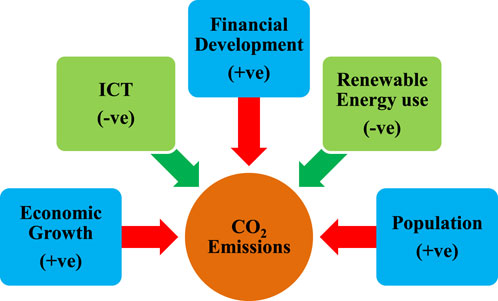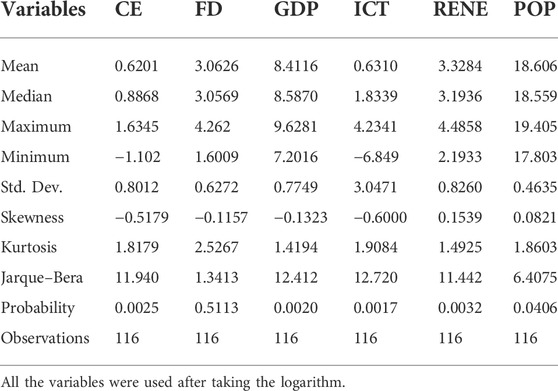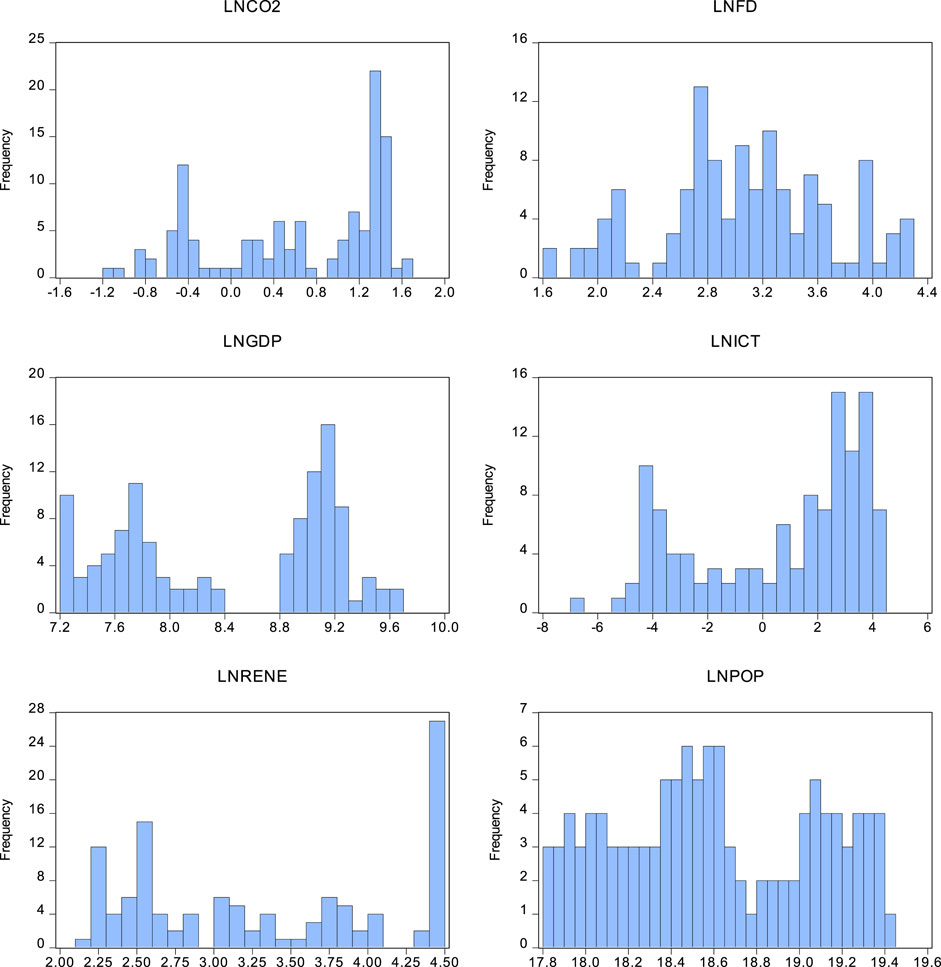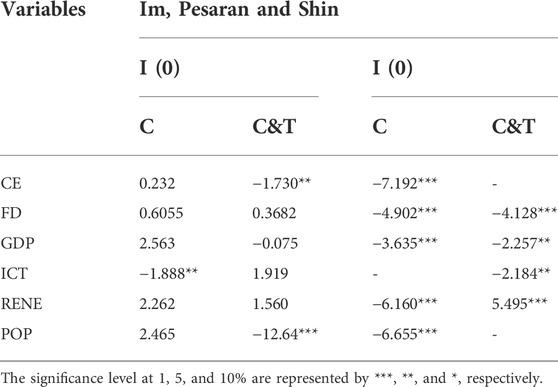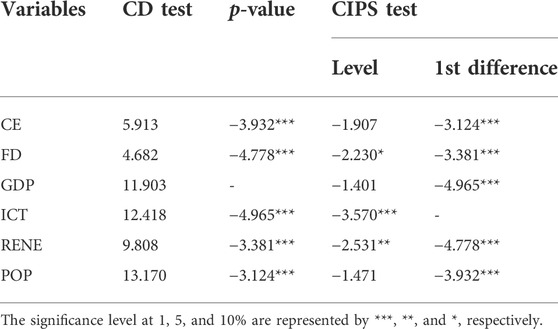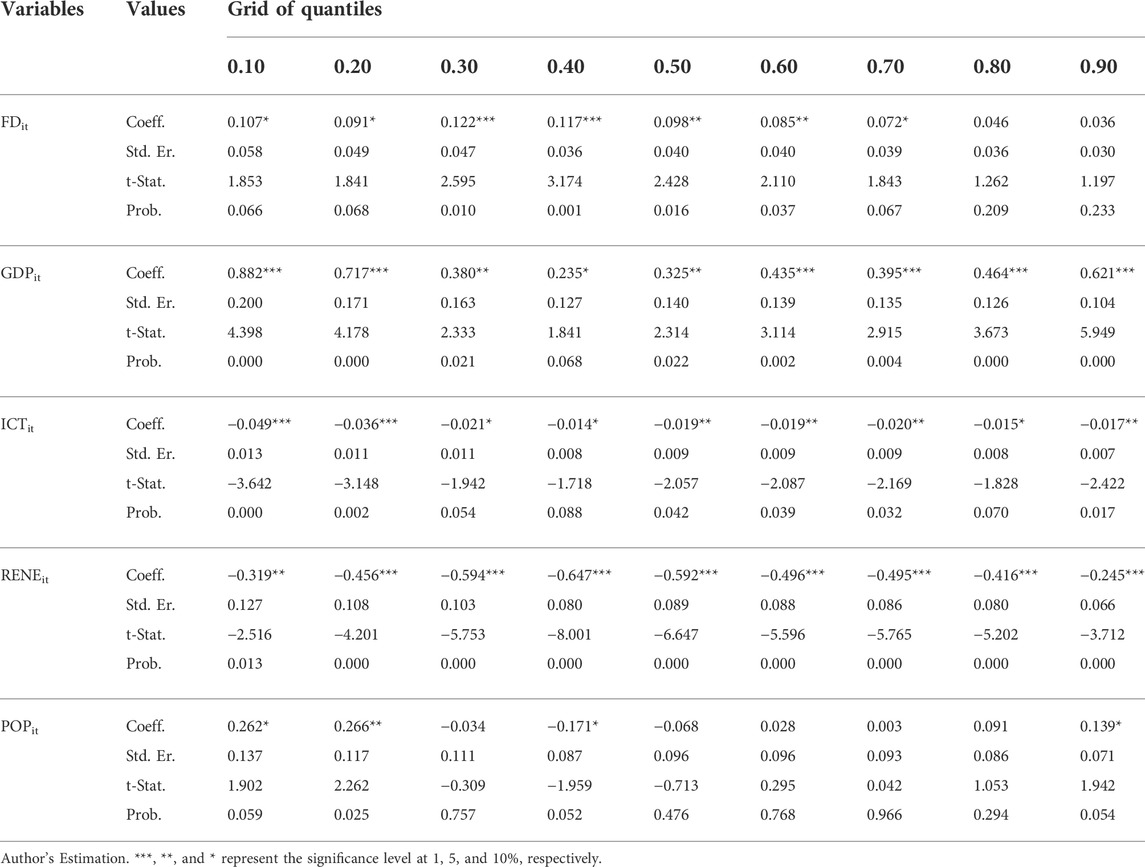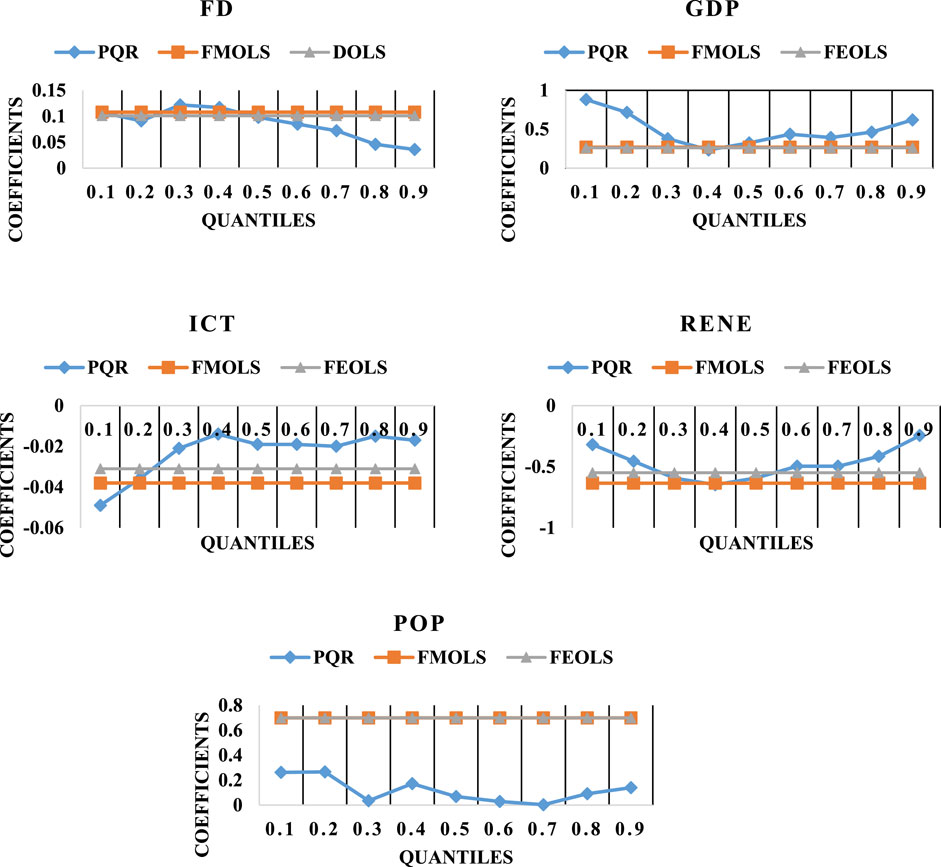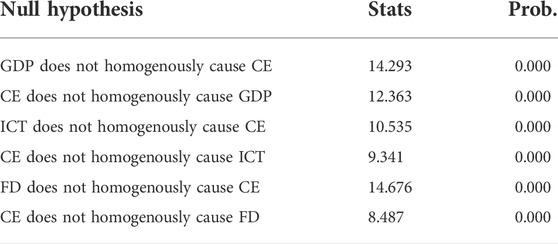- 1College of Resource and Environment, Henan University of Economics and Law, Zhengzhou, China
- 2Collaborative Innovation Center of Urban-Rural Coordinated Development in Henan, Zhengzhou, China
- 3Academician Laboratory for Urban and Rural Spatial Data Mining, Zhengzhou, China
- 4University of Lahore, Lahore, Pakistan
- 5China Institute of Development Strategy and Planning, Institute for Region and Urban-Rural Development, Wuhan University, Wuhan, China
- 6Department of Basic Sciences, College of Science and Theoretical Studies, Saudi Electronic University, Dammam, Saudi Arabia
- 7Planning Department, Punjab Transport Company, Government of Punjab, Lahore, Pakistan
- 8Department of Economics, National College of Business Administration and Economics, Lahore, Pakistan
- 9Department of Business Administration, ILMA University, Karachi, Pakistan
- 10Department of Basic Science, College of Science and Theoretical Studies, Saudi Electronic University, Riyadh, Saudi Arabia
- 11Department of Economics, COMSATS University Islamabad, Lahore Campus, Lahore, Pakistan
Over the last few years, the rapid growth of information and communication technologies (ICT) has contributed to every sector of the economy; however, the environmental consequences of ICT should not be overlooked. In doing so, this research investigated the asymmetric impact of ICT, renewable energy consumption (RENE), economic growth (GDP), financial development (FD), and population (POP) on CO2 emissions (CE) in the MINT countries over the period from 1990 to 2018. For this purpose, this study used STIRPAT and quantile regression. The preliminary outcomes reject the assumption of data normality; therefore, it is very necessary to use the quantile regression (QR), as the QR technique can deal with structural changes, outliers, and data non-normality. The results of QR indicate that ICT reduce carbon emissions across all the quantiles (1st quantile to 9th quantile). Similarly, RENE impedes the carbon emissions across all (1st–9th) quantiles. On the other hand, FD, GDP, and POP increase the carbon emissions across all the quantiles (1st–9th). These outcomes purposed appropriate policy implications for MINT countries.
Introduction
During the last few years, information and communication technologies (ICT) have shown extraordinary performance in increasing productivity and quality of life (Lee et al., 2016; Faisal et al., 2020). ICT has equally assisted firms and households to increase their productivity, and it is recognized as helpful for firms to make an assessment with nominal costs and significantly increase productivity (Vu, 2011). According to Chen and Zhu (2004), the effective utilization of ICT gives a chance to emerging economies to get knowledge and information and let them incorporate with the rest of the world and enhance their competitiveness. This effective utilization of ICT has influenced peoples’ lives through different aspects such as consumer, business, and wealth effects. In this regard, Faisal et al. (2018) argued that it is impossible to ignore the role of financial development (FD) as it controls the IT sector’s investments, which allows customers to implement an economical and lucrative technology.
Recently, the FD has considerably influenced ICT usage. Mun et al. (2008) found that FD has a long-term impact on economic progress via ICT. ICT encourages the way toward the dissemination of information to firms and families, therefore, diminishing the degree of information asymmetry. ICT additionally delivers the borrowers’ credit history to the financial institution to minimize adverse choices. This procedure likewise permits the banks to diminish money-related imperatives in progressing monetary credit access to enterprises of small and medium scale. On the other hand, it provides information related to lenders and credit to the general public. In a study conducted by Asongu and Nwachukwu (2017), it is identified that ICT plays a major role in the formal and informal financial sectors. In developed economies, the formal financial sector is extra efficient and disciplined.
ICT is a useful tool for effective credit allocation, promoting financial transactions, and encouraging financial inclusion (Datta and Agarwal, 2004). Some studies have shown that ICT could further boost the financial sector’s performance by attracting investment in digital technology, which facilitates the cross-border sale of services and abundant and low-cost labor. To lift individuals out of poverty and those residing in remote areas can easily take out microloans and participate in e-banking via ICT. The financial sector supports companies and industries to develop new environmentally friendly technologies. As aforementioned evidence shows that ICT has a substantial role in promoting the activities of the financial sector and enhancing economic growth.
Global warming is presently a worldwide issue that goes away from the borders of the nations (Benzie & Persson, 2019). Each nation is looking at the changing patterns of weather and ocean levels which harshly upset the economies and individual’s life. Moreover, the rise in greenhouse gases, especially CO2, which is currently at the most elevated level ever, is frequently asserted as the primary driver of global warming or climate change (Rogelj & Schleussner, 2019). Actually, since the 1990s, the carbon dioxide from the economic activities of recently industrialized nations has surpassed those of developed (Kasman & Duman, 2015). The threat of climate change calls for more attention from all countries around the world.
Furthermore, the United Nations offered the Sustainable Development Goals (SDGs) to report the essential thought-provoking concerns, for instance, ensuring justice and peace, inequality and poverty reduction, and specifically fighting climate change and environmental degradation. Due to the alarming situation of environmental deterioration, recent studies on the growth-environment nexus have gotten more attention (Bakhsh et al., 2017). Although a desirable rate of growth is a fundamental target for each economy, developed nations have more concerns regarding their environmental impacts (Raworth, 2017). On the other side, to attain a desirable growth rate and development, emerging economies tend to ignore these thoughtful problems. Accordingly, the poor individuals in developing countries are mostly affected by such issues. In this manner, worldwide participation in handling these borderless issues could assist economies to grow in a viable manner (Benzie and Persson, 2019).
Environmental pollution has become a worldwide issue that demands a deliberate effort to reduce CO2 emissions. Defining and designing appropriate energy, economic, and environmental policies that will help to minimize global CO2 emissions remains a top priority for all governmental and non-governmental environmental organizations around the world. In this digital era, researchers have been paying special attention to the expanding use of ICT and its interconnection with economic and environmental aspects. Numerous studies suggest that more use of ICT has a progressive influence on environmental pollution. For example, Park et al. (2018) and Lee and Brahmasrene (2014) identified that the use of ICT is a cause of environmental pollution. In fast-growing economies, the extensive use of ICT increases the process of environmental deterioration through more use of energy and electricity (Moyer and Hughes, 2012). In addition, cumulative use of ICT together with computer equipment adds 2% of global greenhouse gasses (GHG) emissions by using over 3.9% of total energy (Malmodin et al., 2010). Some studies propose that ICT reduces environmental pollution through environmentally friendly technologies. Batool et al. (2019) believed that more usage of ICT in the development process helps to decrease environmental deterioration. Similar evidence was provided by Ollo-López and Aramendía-Muneta (2012), who suggested that ICT improves the quality of the environment by reducing GHG emissions. Subsequently, in 81 developing countries, ICT is negatively connected with environmental pollution through less traveling and dematerialization Mirza et al. (2020).
After all the aforementioned discussions, we concluded that the impact of ICT on CE is still mixed and inconclusive. Few studies provide evidence that ICT reduces the CE, whereas some studies show that ICT is a cause of environmental pollution. Therefore, these inconclusive outcomes show a need to re-examine the impact of ICT on CE. For this purpose, we examined the impact of ICT, FD, GDP, RENE, and POP on CE for MINT countries during 1990–2018. The reason behind the selection of MINT countries is the fast rate of economic growth. World Bank (2019) suggests that MINT shall be among the top 20 economies with a total GDP value of almost 22.4 trillion dollars by 2030.
The present study deviated from the bulk of studies present in the literature by employing the quantile regression technique to explore the strength of the growth-emission link with ICT, RENE, and FD across various quantiles of the conditional distribution of carbon emission in MINT countries. Quantile regression has several advantages over conventional techniques: First, this technique has the ability to address the issue of outliers which occur due to numerous reasons such as financial crises, banking sector crises, and pandemics; on the other hand, conventional techniques have a shortcoming to control the impact of outliers. Second, this technique delivers a set of coefficients according to the nature of the data, whereas conventional techniques, which are based on the mean value, provide only one coefficient. Therefore, this technique provides a true picture of the result compared to conventional mean-based estimations. As per our knowledge, this is the leading study which examined the growth accelerating CO2 emission in MINT nations by incorporating the quantile regression technique.
The remaining part of this article covers the subsequent sections: In Section 2, the review of literature is discussed. Section 3 explains the methodology of quantile regression. The outcome and debate about the findings are interpreted in Section 4. Last, the conclusion and valid policy recommendations for the MINT countries are provided in Section 5.
Literature review
There are a number of studies which have inspected the influence of ICT development on environmental pollution. For 13 selected countries from G20 economies, Nguyen et al. (2020) scrutinized that FD and GDP have a progressive impact on CO2 emission, whereas ICT has a favorable affirmative impact on the environment via reducing the CE. For G7 economies from 1990–2014, Raheem et al. (2020) have explored the connection between ICT, FD, GDP, and pollutant emissions. They documented that the separate impact of ICT and FD on the quality of the environment is negative, whereas the combined effect of these indicators on the environment is positive. In the case of 59 economies along to Belt and Road, Danish (2019) discovered the link between ICT, income, and CE from 1990–2016. The outcomes stated that ICT improves the quality of the environment in economies besides Belt and Road.
Nagao et al. (2017) discovered that ICT has an inverse association with pollution in Japan. Lee and Brahmasrene (2014) scrutinized the positive ICT impact on emissions in ASEAN economies for the period 1991 to 2009. In 2015, Salahuddin & Alam analyzed the ICT effects on CO2 in Australia by applying ARDL bound testing technique. The empirical outcomes suggested that ICT has an affirmative influence on environmental pollution through more usage of energy. Recently, Shahbaz et al. (2020) explored the link of FD with CE in the United Arab Emirates during 1975–2014. They found that environmental pollution is caused by FD. Similarly, Javed and Sharif (2016) explored the connection among emissions of pollutants, FD, and economic growth. The findings of their study validated EKC but proposed that FD is a culprit of environmental degradation.
ICT offers tools and technologies for increased energy efficiency. The ICT industry promotes a low-carbon lifestyle. ICT goods have altered and transformed how people behave and how society functions. People are more inclined to use ICT products because they make work and life more convenient and efficient. Simultaneously, the use of ICT products promotes a low-carbon lifestyle. Dematerialization has occurred as a result of ICT goods such as e-paper and e-books, which have induced a shift from material to immaterial resources to detach resource use from economic output. For instance, letters are replaced with emails with almost instant communication and less consumption of energy and resources (Hilty et al., 2011). The ICT industry enables a low-carbon economic transition and thus contributes to reducing CE (Zhang & Liu, 2015).
For the past few years, the influence of ICT on the environment has been a hot topic. The harmful impacts of CE on human health and the preservation of the environment for future generations have prompted attention to this issue (Zeng et al., 2021). In this respect, two significant environmental nexuses are considered crucial. First, the influence of ICT on CE, and second, the impact of RENE on CE. ICT reduces CE, enhances energy efficiency, and conserves energy (Ozcan & Apergis 2018). According to Charfeddine & Kahia (2021), ICT affects CO2 emission in three ways. The first-order effect is a direct effect that is directly tied to the physical existence or creation of an ICT product. The environment’s quality will continue to deteriorate as energy consumption rises throughout an ICT product’s lifecycle based on these first-order effects. The second-order effect is the use of ICT on the environment. The positive effects of using ICT applications, for instance, smart grids, smart buildings, and intelligent transportation systems are primarily responsible for these effects. The third-order effects of ICT on the environment are also known as rebound effects, in which the beneficial influence of ICT on the environment is counterbalanced by the negative effects. Charfeddine & Kahia (2021) also discovered the first-order impacts of ICT use on CE for MENA countries.
Danish et al. (2018) scrutinized the impression of ICT, FD, and GDP on CE for MENA economies by applying the panel mean group (MG) approach. They found that ICT, FD, and GDP promote CE. Similarly, Park et al. (2018) inspected the link between ICT, FD, GDP, and CE for EU economies during 2001–2014. They found that ICT deteriorated the environmental quality. They also discovered that FD and GDP reduce CE. Arshad et al. (2020) determined the effect of ICT, FD, and GDP on CE for the South and Southeast Asian (SSEA) region. The empirical outcomes of their study demonstrate that FD, ICT, and GDP have a positive link with CE. On the other hand, Danish et al. (2019) stated that FD impedes CE in developed countries. ICT reduces CE in middle and high-income economies, whereas ICT upsurges the CE in low-income economies.
Khan et al. (2022) used four proxies for ICT while examining its effect on carbon emissions in BRICS countries. They found that two proxies, cellular mobiles and fixed broadband, significantly decrease CO2 emissions; however, the other two proxies, Internet use and fixed telephone, have an insignificant influence on carbon emissions in their selected sample countries. They also discovered that RENE reduces carbon emissions significantly. Chien et al. (2021) investigated the same relationship in BRICS countries by applying quantile regression. They found that GDP and FD make a significant contribution to CE at all quantiles, whereas ICT considerably reduces CE, mainly at lower levels quantiles.
In another study, Nguyen et al. (2020) found that only five factors, including energy pricing, FDI, and ICT, reduce CE, whereas financial development contributes to CE. The findings of Ramzan et al. (2022) showed that ICT improves environmental quality by lowering CE, whereas GDP, FD, and globalization increase CE. Chen et al. (2019) used Internet penetration and mobile phone penetration as proxies to quantify ICT. They discovered that ICT has a considerable negative influence on CE. By using the DOLS approach, Dehghan Shabani and Shahnazi (2019) analyzed the connection among GDP, ICT, and CE by using the data from Iran. The researchers found that ICT has a beneficial influence on CO in the industrial sector and a negative influence on CE in the residential sector. Renewable energy was found to be a cost-effective strategy for reducing CE. Therefore, it was recommended to use renewable energy sources (Charfeddine & Kahia, 2021).
Odugbesan and Rjoub (2020) inspected the link between GDP, urbanization, energy usage, and CE in MINT economies during 1993–2017. They discovered that GDP, urbanization, and energy usage increase the CE. Adebayo et al. (2022) documented that FD was responsible for CE in MINT economics during 1969–2019. They found a one-way causal association between FD and CE. By using NARDL during 1990–2014 for MINT countries, Akram et al. (2022) inspected the impression of energy efficiency and RENE on CE. They found that energy efficiency and RENE have a negative link with CE. Adebayo et al. (2022) scrutinized the link between GDP, RENE, non-renewable energy usage, globalization, and CE for MINT countries during 1990–2018. They found that GDP and non-renewable energy usage have a positive link, whereas RENE and globalization have a negative link with CE.
Data and methodology
Data source and model
This study investigated the impact of ICT, FD, RENE, GDP, and POP on CE by using the annual data of MINT countries (Mexico, Indonesia, Nigeria, and Turkey) from 1990 to 2018. For this purpose, we used the quantile regression technique to explore the impact of independent variables on the conditional distribution of CE at various quantiles. This technique is important for many reasons. First, this technique can address the issue of outliers which occur due to numerous reasons such as financial crises, banking sector crises, and pandemics; on the other hand, conventional techniques have a shortcoming to control the impact of outliers. Second, this technique provides a set of coefficients according to the nature of the data, whereas conventional techniques, which are based on the mean value, provide only one coefficient. Therefore, this technique provides a true picture of the result compared to conventional mean-based estimations. The data on CO2 emissions (CE) is collected from the British Petroleum database (BP-statistics, 2021), while the data for information and communication technology (measured by individuals using the Internet, percentage of population), economic growth (GDP per capita), renewable energy consumption (percentage of total energy consumption), financial development (domestic credit to the private sector), and population (number of individuals) is obtained from world development indicators (World Bank, 2021). This study uses the long-linear STIRPAT model to estimate the impact of independent variables on carbon emissions.
In Eq. 1, “ln” represents the logarithm, and “t” and “i” show the time period and number of countries, respectively. The term “e” shows the error term.
Data description and summary statistics
Table 1 depicts the descriptive statistics of the desired factors. The outcomes show that the mean values of CE, FD, GDP, ICT, RENE, and POP are 0.620, 3.062, 8.411, 0.631, 3.328, and 18.606, respectively. Similarly, the CE, FD, GDP, ICT, RENE, and POP have maximum values of 1.634, 4.262, 9.628, 4.234, 4.485, and 19.405, respectively.
One of the most important outputs of Table 1 is the p-values of the Jarque–Bera test, which is less than 0.05, which reject the assumption of normality of data. Therefore, in such a situation, the use of conventional estimation techniques may provide misleading outcomes.
Figure 1 depicts the graphical representation of the data and confirms the results of the J-B test as data non-normality. In such a situation, the use of linear estimation techniques may not produce reliable results. Therefore, it is imperative to use quantile regression which can address the issue of quantiles.
Empirical results
Test of unit root
To observe the properties of the factors, numerous tests are applied to the data. The paramount step is to ratify variables’ stationarity. For this purpose, we used Im et al. (2003) test. In panel data, Im, Pesaran, and Shin (2003) assume a separate autoregressive parameter for every individual. So, in this study, we used the Im, Pesaran, and shin (2003) test. The results of stationarity show that, at the first difference, all variables portray stationarity, while at the level, all variable portrays non-stationary, as shown in Table 2.
Cross-sectional dependence test and CIPS unit root test
The cross-sectional dependence (CD) can misrepresent the real values of the estimated coefficient of the parameter. CD, which may arise because of ignored common components, can incredibly lessen panel data ability gains whenever disregarded (Phillips and Sul, 2003). It is, in this way, imperative to consider this issue to deliver vigorous estimates of coefficient. We used the cross-sectional dependence test of Pesaran (2004) to measure the cross-sectional dependency inside the panel. The result in Table 3 states that across the countries, all variables have cross-sectional dependence. Therefore, our all-other estimation techniques should include procedures that are vigorous to the impact of CD so could alleviate the possible size misrepresentations. Therefore, in this study, we used the CIPS test of a unit root. This test depends on the CD hypothesis, and it is vital for cointegration models of panel data. The test of CIPS is used to analyze the incorporation order of the factors. According to this test, if all the under-examined factors are integrated at the same level, for instance, I (1), this means all data sets are stationary at the first difference, and it is inclined to the subject that in the long run, all the factors in the data set might have an association (Table 3).
Test of panel cointegration
To find out the occurrence of a non-misleading long-term relationship among the factors, we used the cointegration test of Pedroni (2004) and bootstrapped cointegration test of Westerlund (2007). Wasterlund (2007) suggested four different types of tests of no cointegration with a null hypothesis. This technique loosens the burden of common indicator limitations on tests dependent on residual elements because these elements are structural as opposed to residuals. Kremers et al. (1992) proposed that structural elements are essential because the non-fulfillment of common indicator limitations could considerably decrease the intensity of tests based on residuals for cointegration. By eliminating this limitation, the adjustment procedures for short- and long-term need not be indistinguishable. Utilizing the bootstrap method of Westerlund (2007), we can produce robust critical values by moderating the distortionary impacts of cross-sectional dependence. Pedroni (2004) suggests a detailed structure for panel cointegration under the 2-step methodology of Engle and Granger. To control the heterogeneity, Pedroni’s methodology sifts out short-term factors and individual-explicit deterministic patterns in the initial stage of the system. In light of evaluated residuals, Pedroni determines seven diverse test measurements that could either be those expecting a typical procedure, usually meant as “within-dimension” or “pooled” tests, and those expecting individual procedures indicated as “between-dimension” or “grouped” tests in Table 4.
The findings of the test of Pedroni cointegration in Table 4 illustrate those three tests within measurement (Panel ADF statistics, Panel PP statistics, and Panel v statistics) and two tests between dimensions (group ADF statistics and group PP statistics) highly significantly reject the null hypothesis at 1% and affirms the existence of cointegration amidst the variables. The result of the five tests out of seven shows that variables are moving together in the long run.
Results of panel estimation
Table 5 describes the outcomes of FMOLS and FE-OLS. The findings of both the techniques are almost the same, as results show that a 1% rise in FD increases the CE by 0.108 and 0.101% in the case of FMOLS and FE-OLS, respectively. This positive impact of FD on CE implies that the financial sector of MINT countries is ignoring the adverse impact of environmental pollution at the time of lending or investment. This result is similar to the findings of Farooq et al. (2021), Anwar et al. (2022b) and Anwar et al. (2021c). Similarly, a 1% increase in GDP raises CE by 0.269 and 0.262 in the case of FMOLS and FE-OLS, respectively. This positive association between GDP and CE result is witnessed that the current growth process of MINT economies is not properly environment friendly. This finding is similar to the findings of Anser et al. (2021b), Hashmi et al. (2021), Anwar et al. (2021a), Husnain et al. (2022), Anwar et al. (2021b), and Liu et al. (2022).
ICT reduces the CE by 0.038 and 0.031% in the case of FMOLS and FE-OLS, respectively. This outcome indicates that the ICT is on the right path in MINT countries, but the small values of coefficients show that the impact of ICT on CE is very low. This finding is in line with the results of Chien et al. (2021) and Godil et al. (2021). Moreover, RENE also reduces the CE. A 1% increase in RENE impedes CE by 0.635 and 0.549% in the case of FEMOLS and FE-OLS, respectively. This result shows the efforts of MINT countries in the adoption of renewable energy in their production process. The adoption of renewable energy reduces the dependence on fossil fuels and helps to improve the quality of the environment. The findings are similar to the findings of Habiba et al. (2022), Sun et al. (2022), Anwar et al. (2021a), Salem et al. (2021), and Anser et al. (2021a).
Results of quantile regression
The findings of panel quantile estimation are represented in Table 6, which shows that FD has a positive influence on CE across all the quantiles (1st–9th). The outcomes are similar to the findings of Anwar et al. (2021c), Farooq et al. (2021), Al-Mulali et al. (2015), and Shahbaz et al. (2020), who suggested that financial development may increase the production process and increase more use of conventional energy which led to decrease in environmental quality. Similarly, economic growth increases the carbon emission across all the quantiles (1st–9th). This finding is in line with those of Anwar et al. (2022a), Anwar and Malik (2021), and Jun et al. (2021), who claimed that the increase in economic growth might be in the form of more energy use through urbanization, industrialization, and transportation which increases the CE.
However, ICT has a negative link with CE across all the quantiles (1st to 9th). This outcome is similar to the findings of Chien et al. (2021) and Godil et al. (2020), who claimed that ICT impedes the CE through more use of energy-efficient technologies. This outcome is opposite to the findings of Park et al. (2018) and Lee and Brahmasrene (2014), who concluded that ICT is positively linked with carbon emissions. RENE also reduces the CE across all quantiles. This result is in line with the findings of Syed et al. (2022), Anwar et al. (2021c), Cai et al. (2021), and Salem et al. (2021). Lastly, the population increases the environmental degradation by more use of energy consumption. Figure 2 shows the comparison of the coefficients of FMOLS, DOLS, and Quantile Regression.
The bi-directionality is considered an important instrument for policy framework, as this relationship shows the reverse impact of independent variables on dependent variables. Therefore, the present study used a heterogenous panel causality test, and the results are present in Table 7. The results demonstrate that GDP and CO2 emissions have a two-way causality relationship. This result is witnessed in the negative effects of economic growth of MINT countries on carbon emissions. Similarly, a bidirectional causality exists between ICT and carbon emissions. Moreover, a two-way causal association also exists between FD and CO2 emission.
Conclusion and policy implications
The study was modeled to analyze the impact of ICT, RENE, GDP, and FD on CO2 emissions in MINT nations. For this purpose, we used the quantile regression (QR) approach. Before applying the QR technique, we used some reliability tests (Im, Pesaran, and Shin 2003; CIPS unit root test and Pesaran 2004 CD test) to check the reliability of the data. Then, we applied Pedroni’s (1999) and Westerlund’s (2007) bootstrap panel cointegration test to analyze the cointegration between the variable. After testing the pre-requisite tests, we used FMOLS and FEOLS to assess the long-run association among the aforementioned factors. The findings of FMOLS and FEOLS demonstrated that FD, GDP, and POP have an affirmative relationship, whereas ICT and RENE have a negative relationship with CO2 emission. Similarly, our quantile result demonstrates that ICT and RENE have a negative link, whereas FD, GDP, and POP have a positive link with CO2 emissions.
Policy implications
Based on the empirical outcomes of this study, we recommend the following policy implications to the policymakers and governments of MINT countries for achieving sustainable development.
1) Empirical findings of this study show that ICT has a negative association with carbon emissions. Therefore, the governments of MINT countries should provide tax rebates and subsidies to those firms that promote and produce environment-friendly ICT products.
2) Online shopping using ICT devices is also a useful tool to reduce transport-related emissions. Therefore, governments should also provide Internet for ICT technologies (mobile and the Internet) at cheap rates to encourage online shopping and purchase from far distances. Moreover, there is a requirement to introduce more advancement by research and development in the financial segment presenting the upgrade of the speed of the Internet and its usage.
3) ICT can also be used for awareness campaigns regarding the adverse impact of environmental pollution and suitable ways to improve environmental quality in order to achieve sustainable development.
4) According to the results of the present study, financial development is increasing carbon emissions in MINT countries. Therefore, the government institutions and central banks of these countries should strictly monitor the lending and investment of financial institutions and encourage them to invest in environment-friendly projects.
5) Empirical outcomes of this study show that renewable energy is helpful in improving the quality of the environment. Therefore, carbon emission tax, charging a higher price for fossil fuels, and eliminating fossil fuel subsidies can be promoted to reduce environmental damage.
Limitations of the study
The present study is based on the panel data of MINT countries, while the role of ICT on economic growth and the environment may be different in these four countries. Therefore, a country-specific study will be more useful for policymakers. Moreover, this study used only one proxy of ICT (individuals using the Internet) for measuring its impact on environmental pollution, while there are a number of other proxies which can be used to check their impact on the environment.
Data availability statement
Publicly available datasets were analyzed in this study. The data can be found at: https://data.worldbank.org/.
Author contributions
YW: conceptualization and methodology. MS: data collection. MH: writing–reviewing and editing. MUK: supervision and software. AA: writing—original draft preparation, revisions, and reviewing and editing. MOK: editing. SM: literature review.
Funding
This work was supported by the National Natural Science Foundation of China (No. 41701141).
Acknowledgments
The authors would like to express their gratitude to Saudi Electronic University for facilitating this study.
Conflict of interest
The authors declare that the research was conducted in the absence of any commercial or financial relationships that could be construed as a potential conflict of interest.
Publisher’s note
All claims expressed in this article are solely those of the authors and do not necessarily represent those of their affiliated organizations, or those of the publisher, the editors, and the reviewers. Any product that may be evaluated in this article, or claim that may be made by its manufacturer, is not guaranteed or endorsed by the publisher.
References
Adebayo, T. S., Awosusi, A. A., Rjoub, H., Agyekum, E. B., and Kirikkaleli, D. (2022). The influence of renewable energy usage on consumption-based carbon emissions in MINT economies. Heliyon 8 (2), e08941. doi:10.1016/j.heliyon.2022.e08941
Akram, R., Umar, M., Xiaoli, G., and Chen, F. (2022). Dynamic linkages between energy efficiency, renewable energy along with economic growth and carbon emission. A case of MINT countries an asymmetric analysis. Energy Rep. 8, 2119–2130. doi:10.1016/j.egyr.2022.01.153
Al-Mulali, U., Ozturk, I., and Lean, H. H. (2015). The influence of economic growth, urbanization, trade openness, financial development, and renewable energy on pollution in Europe. Nat. Haz. 79 (1), 621–644.
Anser, M. K., Syed, Q. R., Lean, H. H., Alola, A. A., and Ahmad, M. (2021a). Do economic policy uncertainty and geopolitical risk lead to environmental degradation? Evidence from emerging economies. Sustainability 13 (11), 5866. doi:10.3390/su13115866
Anser, M. K., Apergis, N., and Syed, Q. R. (2021b). Impact of economic policy uncertainty on CO2 emissions: Evidence from top ten carbon emitter countries. Environ. Sci. Pollut. Res. 28 (23), 29369–29378. doi:10.1007/s11356-021-12782-4
Anwar, A., and Malik, S. (2021). Cogitating the role of technological innovation and institutional quality on environmental degradation in G-7 countries. Int. J. Green Econ. 15 (3), 213–232. doi:10.1504/ijge.2021.120871
Anwar, A., Sharif, A., Fatima, S., Ahmad, P., Sinha, A., Rehman Khan, S. A., et al. (2021a). The asymmetric effect of public private partnership investment on transport CO2 emission in China: Evidence from quantile ARDL approach. J. Clean. Prod. 288, 125282. doi:10.1016/j.jclepro.2020.125282
Anwar, A., Siddique, M., Eyup Dogan, E., and Sharif, A. (2021b). The moderating role of renewable and non-renewable energy in environment-income nexus for ASEAN countries: Evidence from Method of Moments Quantile Regression. Renew. Energy 164, 956–967. doi:10.1016/j.renene.2020.09.128
Anwar, A., Chaudhary, A. R., Malik, S., and Bassim, M. (2021c). Modelling the macroeconomic determinants of carbon dioxide emissions in the G-7 countries: The roles of technological innovation and institutional quality improvement. Glob. Bus. Rev., 09721509211039392. doi:10.1177/09721509211039392
Anwar, A., Malik, S., and Ahmad, P. (2022a). Cogitating the role of technological innovation and institutional quality in formulating the sustainable development goal policies for E7 countries: Evidence from quantile regression. Glob. Bus. Rev., 09721509211072657. doi:10.1177/09721509211072657
Anwar, A., Sinha, A., Sharif, A., Siddique, M., Irshad, S., Anwar, W., et al. (2022b). The nexus between urbanization, renewable energy consumption, financial development, and CO2 emissions: Evidence from selected asian countries. Environ. Dev. Sustain 24 (5), 6556–6576. doi:10.1007/s10668-021-01716-2
Anwar, A., Chaudhary, A. R., and Malik, S. (2022c). Modeling the macroeconomic determinants of environmental degradation in E-7 countries: The role of technological innovation and institutional quality. J. Public Aff., e2834.
Arshad, Z., Robaina, M., and Botelho, A. (2020). The role of ICT in energy consumption and environment: An empirical investigation of asian economies with cluster analysis. Environ. Sci. Pollut. Res. 27, 32913–32932. doi:10.1007/s11356-020-09229-7
Asongu, S. A., and Nwachukwu, J. C. (2017). The synergy of financial sector development and information sharing in financial access: Propositions and empirical evidence. Res. Int. Bus. Finance 40, 242–258. doi:10.1016/j.ribaf.2017.03.001
Bakhsh, K., Rose, S., Ali, M. F., Ahmad, N., and Shahbaz, M. (2017). Economic growth, CO 2 emissions, renewable waste and FDI relation in Pakistan: New evidences from 3SLS. J. Environ. Manag. 196, 627–632. doi:10.1016/j.jenvman.2017.03.029
Batool, R., Sharif, A., Islam, T., Zaman, K., Shoukry, A. M., Sharkawy, M. A., et al. (2019). Green is clean: The role of ICT in resource management. Environ. Sci. Pollut. Res. 26 (24), 25341–25358. doi:10.1007/s11356-019-05748-0
Benzie, M., and Persson, Å. (2019). Governing borderless climate risks: Moving beyond the territorial framing of adaptation. Int. Environ. Agreements Polit. Law Econ. 19 (4-5), 369–393. doi:10.1007/s10784-019-09441-y
Cai, Y., Xu, J., Ahmad, P., and Anwar, A. (2021). What drives carbon emissions in the long-run? The role of renewable energy and agriculture in achieving the sustainable development goals. Econ. Research-Ekonomska Istraživanja, 1–22. doi:10.1080/1331677X.2021.2015613
Charfeddine, L., and Kahia, M. (2021). Do information and communication technology and renewable energy use matter for carbon dioxide emissions reduction? Evidence from the Middle East and north africa region. J. Clean. Prod. 327, 129410. doi:10.1016/j.jclepro.2021.129410
Chen, X., Gong, X., Li, D., and Zhang, J. (2019). Can information and communication technology reduce CO2 emission? A quantile regression analysis. Environ. Sci. Pollut. Res. 26, 32977–32992. doi:10.1007/s11356-019-06380-8
Chen, Y., and Zhu, J. (2004). Measuring information technology's indirect impact on firm performance. Inf. Technol. Manag. 5 (1-2), 9–22. doi:10.1023/b:item.0000008075.43543.97
Chien, F., Anwar, A., Hsu, C.-C., Sharif, A., Razzaq, A., and Sinha, A. (2021). The role of information and communication technology in encountering environmental degradation: Proposing an SDG framework for the BRICS countries. Technol. Soc. 65, 101587. doi:10.1016/j.techsoc.2021.101587
Danish, (2019). Effects of information and communication technology and real income on CO2 emissions: The experience of countries along Belt and Road. Telematics Inf. 45, 101300. doi:10.1016/j.tele.2019.101300
Danish , , Khan, N., Baloch, M. A., Saud, S., and Fatima, T. (2018). The effect of ICT on CO2 emissions in emerging economies: Does the level of income matters? Environ. Sci. Pollut. Res. 25 (23), 22850–22860. doi:10.1007/s11356-018-2379-2
Danish, , , Zhang, J., Wang, B., and Latif, Z. (2019). Towards cross‐regional sustainable development: The nexus between information and communication technology, energy consumption, and CO 2 emissions. Sustain. Dev. 27, 990–1000. doi:10.1002/sd.2000
Datta, A., and Agarwal, S. (2004). Telecommunications and economic growth: A panel data approach. Appl. Econ. 36 (15), 1649–1654. doi:10.1080/0003684042000218552
Dehghan Shabani, Z., and Shahnazi, R. (2019). Energy consumption, carbon dioxide emissions, information and communications technology, and gross domestic product in Iranian economic sectors: A panel causality analysis. Energy 169, 1064–1078. doi:10.1016/j.energy.2018.11.062
Faisal, F., Tursoy, T., and Berk, N. (2018). Linear and non-linear impact of internet usage and financial deepening on electricity consumption for Turkey: Empirical evidence from asymmetric causality. Environ. Sci. Pollut. Res. 25 (12), 11536–11555. doi:10.1007/s11356-018-1341-7
Faisal, F., Azizullah, T., Tursoy, T., and Pervaiz, R. (2020). Does ICT lessen CO2 emissions for fast-emerging economies? An application of the heterogeneous panel estimations. Environ. Sci. Pollut. Res. 27 (10), 10778–10789. doi:10.1007/s11356-019-07582-w
Farooq, A., Anwar, A., Ahad, M., Shabbir, G., and Imran, Z. A. (2021). A validity of environmental Kuznets curve under the role of urbanization, financial development index and foreign direct investment in Pakistan. J. Econ. Adm. Sci. doi:10.1108/JEAS-10-2021-0219
Godil, D. I., Sharif, A., Afshan, S., Yousuf, A., and Khan, S. A. R. (2020). The asymmetric role of freight and passenger transportation in testing EKC in the US economy: evidence from QARDL approach. Environ. Sci. Pol. Res. 27 (24), 30108–30117.
Godil, D. I., Yu, Z., Sharif, A., Usman, R., and Khan, S. A. R. (2021). Investigate the role of technology innovation and renewable energy in reducing transport sector CO 2 emission in China: A path toward sustainable development. Sustain. Dev. 29, 694–707. doi:10.1002/sd.2167
Habiba, U., Xinbang, C., and Anwar, A. (2022). Do green technology innovations, financial development, and renewable energy use help to curb carbon emissions? Renew. Energy 193, 1082–1093. doi:10.1016/j.renene.2022.05.084
Hashmi, S. M., Bhowmik, R., Inglesi-Lotz, R., and Syed, Q. R. (2021). Investigating the Environmental Kuznets Curve hypothesis amidst geopolitical risk: Global evidence using bootstrap ARDL approach. Environ. Sci. Pollut. Res. 29, 24049–24062. doi:10.1007/s11356-021-17488-1
Hilty, L. M., Lohmann, W., and Huang, E. M. (2011). Sustainability and ICT – an overview of the field. Notizie Di Politeia 27 (104), 13–28.
Husnain, M. I. u., Syed, Q. R., Bashir, A., and Khan, M. A. (2022). Do geopolitical risk and energy consumption contribute to environmental degradation? Evidence from E7 countries. Environ. Sci. Pollut. Res. 29, 41640–41652. doi:10.1007/s11356-021-17606-z
Im, K. S., Pesaran, M. H., and Shin, Y. (2003). Testing for unit roots in heterogeneous panels. J. Econ. 115 (1), 53–74. doi:10.1016/s0304-4076(03)00092-7
Jun, W., Mughal, N., Zhao, J., Shabbir, M. S., Niedbała, G., Jain, V., et al. (2021). Does globalization matter for environmental degradation? Nexus among energy consumption, economic growth, and carbon dioxide emission. Energy Policy 153, 112230. doi:10.1016/j.enpol.2021.112230
Javid, M., and Sharif, F. (2016). Environmental Kuznets curve and financial development in Pakistan. Renew. Sust. Energy Rev. 54, 406–414.
Kasman, A., and Duman, Y. S. (2015). CO2 emissions, economic growth, energy consumption, trade and urbanization in new EU member and candidate countries: A panel data analysis. Econ. Model. 44, 97–103. doi:10.1016/j.econmod.2014.10.022
Khan, H., Weili, L., and Khan, I. (2022). Examining the effect of information and communication technology, innovations, and renewable energy consumption on CO2 emission: Evidence from BRICS countries. Environ. Sci. Pollut. Res. 29, 47696–47712. doi:10.1007/S11356-022-19283-Y
Kremers, J. J. M., Ericsson, N. R., and Dolado, J. J. (1992). The power of cointegration tests. Oxf. Bull. Econ. statistics 54 (3), 325–348. doi:10.1111/j.1468-0084.1992.tb00005.x
Lee, J. W., and Brahmasrene, T. (2014). ICT, CO2Emissions and economic growth: Evidence from a panel of ASEAN. Glob. Econ. Rev. 43 (2), 93–109. doi:10.1080/1226508x.2014.917803
Lee, S. B., Lee, S. C., and Suh, Y. H. (2016). Technostress from mobile communication and its impact on quality of life and productivity. Total Qual. Manag. Bus. Excell. 27 (7-8), 775–790. doi:10.1080/14783363.2016.1187998
Liu, L., Anwar, A., Irmak, E., and Pelit, I. (2022). Asymmetric linkages between public-private partnership, environmental innovation, and transport emissions. Econ. Research-Ekonomska Istraživanja, 1–22. doi:10.1080/1331677X.2022.2049979
Malmodin, J., Moberg, Å., Lundén, D., Finnveden, G., and Lövehagen, N. (2010). Greenhouse gas emissions and operational electricity use in the ICT and entertainment & media sectors. J. Industrial Ecol. 14 (5), 770–790. doi:10.1111/j.1530-9290.2010.00278.x
Mirza, F. M., Ansar, S., Ullah, K., and Maqsood, F. (2020). The impact of information and communication technologies, CO2 emissions, and energy consumption on inclusive development in developing countries. Environ. Sci. Pollut. Res. 27 (3), 3143–3155. doi:10.1007/s11356-019-07131-5
Moyer, J. D., and Hughes, B. B. (2012). ICTs: Do they contribute to increased carbon emissions? Technol. Forecast. Soc. Change 79 (5), 919–931. doi:10.1016/j.techfore.2011.12.005
Mun, H. W., Siong, E, C., Long, B. S., and Thing, T. C. (2008). Stock Market and Economic Growth in Malaysia: Causality Test Asial Social Sci. 4 (4), 86–92.
Nagao, T., Hara, M., Hannoe, S., and Nakamura, J. (2017). “Estimation of reduction in CO2 emissions by using ICT throughout Japan,” in Sustainability through innovation in product life cycle design (Singapore: Springer), 633–649. doi:10.1007/978-981-10-0471-1_43
Nguyen, T. T., Pham, T. A. T., and Tram, H. T. X. (2020). Role of information and communication technologies and innovation in driving carbon emissions and economic growth in selected G-20 countries. J. Environ. Manag. 261, 110162. doi:10.1016/j.jenvman.2020.110162
Odugbesan, J. A., and Rjoub, H. (2020). Relationship among economic growth, energy consumption, CO2 emission, and urbanization: Evidence from MINT countries. Sage Open 10 (2), 2158244020914648. doi:10.1177/2158244020914648
Ollo-López, A., and Aramendía-Muneta, M. E. (2012). ICT impact on competitiveness, innovation and environment. Telematics Inf. 29 (2), 204–210. doi:10.1016/j.tele.2011.08.002
Ozcan, B., and Apergis, N. (2018). The impact of internet use on air pollution: Evidence from emerging countries. Environ. Sci. Pollut. Res. 25 (5), 4174–4189. doi:10.1007/s11356-017-0825-1
Park, Y., Meng, F., and Baloch, M. A. (2018). The effect of ICT, financial development, growth, and trade openness on CO2 emissions: An empirical analysis. Environ. Sci. Pollut. Res. 25 (30), 30708–30719. doi:10.1007/s11356-018-3108-6
Pedroni, P. (2004). Panel cointegration: Asymptotic and finite sample properties of pooled time series tests with an application to the PPP hypothesis. Econ. theory 20 (3), 597–625. doi:10.1017/s0266466604203073
Pedroni, P. (1999). Critical values for cointegration tests in heterogeneous panels with multiple regressors. Oxford Bulletin Econ. stat. 61 (S1), 653–670.
Phillips, P. C. B., and Sul, D. (2003). Dynamic panel estimation and homogeneity testing under cross section dependence. Econ. J. 6 (1), 217–259. doi:10.1111/1368-423x.00108
Raheem, I. D., Tiwari, A. K., and Balsalobre-Lorente, D. (2020). The role of ICT and financial development in CO2 emissions and economic growth. Environ. Sci. Pollut. Res. 27 (2), 1912–1922. doi:10.1007/s11356-019-06590-0
Ramzan, M., Raza, S. A., Usman, M., Sharma, G. D., and Iqbal, H. A. (2022). Environmental cost of non-renewable energy and economic progress: Do ICT and financial development mitigate some burden? J. Clean. Prod. 333, 130066. doi:10.1016/J.JCLEPRO.2021.130066
Raworth, K. (2017). Doughnut economics: Seven ways to think like a 21st-century economist. Chelsea Green Publishing.
Rogelj, J., and Schleussner, C.-F. (2019). Unintentional unfairness when applying new greenhouse gas emissions metrics at country level. Environ. Res. Lett. 14 (11), 114039. doi:10.1088/1748-9326/ab4928
Salem, S., Arshed, N., Anwar, A., Iqbal, M., and Sattar, N. (2021). Renewable energy consumption and carbon emissions-testing nonlinearity for highly carbon emitting countries. Sustainability 13 (21), 11930. doi:10.3390/su132111930
Shahbaz, M., Haouas, I., Sohag, K., and Ozturk, I. (2020). The financial development-environmental degradation nexus in the united Arab Emirates: The importance of growth, globalization and structural breaks. Environ. Sci. Pollut. Res. Int. 27, 10685–10699. doi:10.1007/s11356-019-07085-8
Sun, Y., Anwar, A., Razzaq, A., Liang, X., and Siddique, M. (2022). Asymmetric role of renewable energy, green innovation, and globalization in deriving environmental sustainability: Evidence from top-10 polluted countries. Renew. Energy 185, 280–290. doi:10.1016/j.renene.2021.12.038
Syed, Q. R., Bhowmik, R., Adedoyin, F. F., Alola, A. A., and Khalid, N. (2022). Do economic policy uncertainty and geopolitical risk surge CO2 emissions? New insights from panel quantile regression approach. Environ. Sci. Pollut. Res. Int. 29, 27845–27861. doi:10.1007/s11356-021-17707-9
Vu, K. M. (2011). ICT as a source of economic growth in the information age: Empirical evidence from the 1996-2005 period. Telecommun. Policy 35 (4), 357–372. doi:10.1016/j.telpol.2011.02.008
Westerlund, J. (2007). Testing for error correction in panel data. Oxf. Bull Econ Stats 69 (6), 709–748. doi:10.1111/j.1468-0084.2007.00477.x
Zeng, S., Jia, J., Su, B., Jiang, C., and Zeng, G. (2021). The volatility spillover effect of the European Union (EU) carbon financial market. J. Clean. Prod. 282, 124394. doi:10.1016/j.jclepro.2020.124394
Keywords: information and communication technologies, renewable energy, quantile regression, financial development, environmental degradation
Citation: Wen Y, Shabbir MS, Haseeb M, Kamal M, Anwar A, Khan MF and Malik S (2022) The dynamic effect of information and communication technology and renewable energy on CO2 emission: Fresh evidence from panel quantile regression. Front. Environ. Sci. 10:953035. doi: 10.3389/fenvs.2022.953035
Received: 25 May 2022; Accepted: 27 June 2022;
Published: 23 August 2022.
Edited by:
Atif Jahanger, Hainan University, ChinaReviewed by:
Malayaranjan Sahoo, National Institute of Technology Rourkela, IndiaBo Yang, Zhongnan University of Economics and Law, China
Chandrashekar Raghutla, National Institute of Technology Puducherry, India
Emran Hossain, Bangladesh Agricultural University, Bangladesh
Penghao Ye, Hainan University, China
Copyright © 2022 Wen, Shabbir, Haseeb, Kamal, Anwar, Khan and Malik. This is an open-access article distributed under the terms of the Creative Commons Attribution License (CC BY). The use, distribution or reproduction in other forums is permitted, provided the original author(s) and the copyright owner(s) are credited and that the original publication in this journal is cited, in accordance with accepted academic practice. No use, distribution or reproduction is permitted which does not comply with these terms.
*Correspondence: Ahsan Anwar, YWhzYW5hbndhcjc4NkBnbWFpbC5jb20=
 Yuzhao Wen
Yuzhao Wen Malik Shahzad Shabbir
Malik Shahzad Shabbir Mohammad Haseeb
Mohammad Haseeb Mustafa Kamal
Mustafa Kamal Ahsan Anwar
Ahsan Anwar Mohammad Faisal Khan
Mohammad Faisal Khan Summaira Malik11
Summaira Malik11